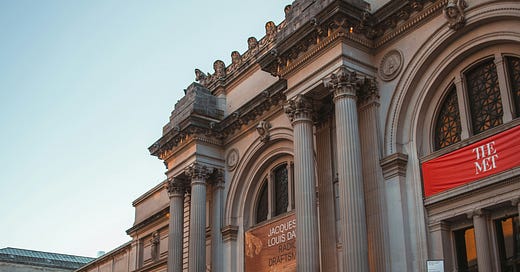How The Met Gala Just Broke the Unspoken Social Contract of Art Institutions and the General Public
The Met Gala of 2024 is the "shot heard around the world" as it broke the social contract between Arts Institutions and the Art Community beyond repair through the theme "Garden of Time".
For many people in the art community, the Met Gala is our Super Bowl. The fashion, the aesthetic, and the spectacle have set the event apart from other celebrity excursions like The Grammy’s or the Oscars through storytelling and a sense of romance. It always seemed like an event for artists, as it is a charity fundraiser for The Met’s costume department.
However, this year, when Anna Wintour chose the theme “Garden of Time” after a short story by J.G. Ballard, the 2024 Met Gala rang dystopian and grotesque, for reasons I’m not sure that she will receive.
Art has, time and time again, been the underpinning of revolutions and philosophical movements. Art institutions have been tasked with preserving these acts of resistance as crucial moments in the global human experience. However, through the “Garden of Time” theme of the 2024 Met Gala, I think that the Metropolitan Museum of Art finds itself on the wrong foot during this current philosophical revolution rooted in class consciousness.
In the words of James Baldwin, “The role of the artist is exactly the same as the role of the lover. If I love you, I have to make you conscious of the things you don’t see.”
We, the public, must show the Met what they cannot see. There is an unspoken social contract among artists and art institutions. Art institutions may lean toward wealth if they consider public interest in the arts through events, grants, education, and preserving our work and voices in museums for future generations. In the case of the Met Gala, the fundraiser was originally meant to support the costume department so that the skilled labor would not be lost to public knowledge.
Artists regularly reinforce the cultural fabric, often at personal risk and expense. It is the duty of arts institutions to minimize those risks through grants, residencies, and general funding, and provide resources through which public art as an expression may survive. However, what is crucial to understand here, is where the Met as an institution sees itself. Anna Wintour may have unknowingly confirmed an inner understanding that the public was supposed to be shielded from.
I believe that Anna Wintour sees herself as the Countess, asking to pick the last time flower in choosing the theme of the 2024 Met Gala before the rabble hoard descends.
In the short story by J.G. Ballard, the Count and Countess may keep enjoying their life at the villa if they routinely pluck a magical time flower from their garden which slows the approach of a motley horde. If the Met Gala 2024 represents the Time Garden, and the celebrities represent the time-stopping flowers, each dripping with delicate jewels and opulence, a momentary distraction that diverts the public horde’s attention from the elite, then where exactly does that place the Metropolitan Museum of Art as an institution?
Systemically, as arts institutions lean toward wealth in the name of funding, they distance themselves from the people they were meant to serve. The Met just showed that distance is intentional, by setting the stage of the red carpet full of beautiful time-stopping flowers while raking in the money by millions through ticket sales and advertising placements. The Met Gala and by extension the Metropolitan Museum of Art as an institution is beholden to the aristocrats, confirming what the art community has long suspected. The garden is not for the people. This is an institutional betrayal.
Anna Wintour as the Countess reveals that she thinks that the public will storm the grounds like a plague, slashing paintings and ripping pages from books. However, the Met as an arts institution is for the people, so that we may better understand our humanity through 5,000 years of art from all over the world. The Met is the garden that the Count and Countess allowed to die.
What many elites seem to struggle with is that the general public views these gouche displays through a Meta-modernist lens. They are more aware of themselves in the social hierarchy and global events and are no longer content with “bread and circuses.”
For this reason, I think that the Metropolitan Museum of Art needs to reconsider itself as an institution if its aim is to maintain a positive relationship with the general public. It is within their best interest to distance themselves from Anna Wintour’s biased vision indefinitely. We find it difficult to believe that no one took the time to read the 6-page short story by J.G. Ballard and question Anna Wintour’s vision. An institution that holds our collective history cannot be allowed to weaponize ignorance.



